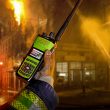InterAct unveils CAD module
InterAct Public Safety Systems unveiled the CalypsoPWC, a WebCAD display system that pulls selected incident information directly from computer-aided dispatch (CAD) systems used by 911 call centers and transmits it in real time to the media and the public, said Jennifer Filipowski, the company’s executive vice president of marketing.
The system includes a module that plugs into InterAct’s CAD system, so agencies interested in the technology must have the company’s system in place or purchase the entire system, Filipowski said. Once installed, it searches data entered into the system by call takers and dispatchers, then extracts specific incident and event details. Such data are then uploaded to a web page that can be viewed by the general public and media.
Incidents also are displayed on a map, allowing the public and media to immediately identify potential traffic problems and other hazards. Emergency-management personnel have complete control over what types of incidents are made publicly available and the level of detail provided about each one, Filipowski said.
“Once the setup is done, depending on event coding, different criteria can be used to filter out which incident types are displayed on the website,” she said. “In other words, you can set it to display certain details and information about each incident and restrict other details.”
The Pennsylvania State Police recently invested in the module to reduce traffic inquiries coming into the 911 center, said Capt. John Dougherty, director of the state police’s dispatch operations division. The dispatch is considered a secondary dispatch point, as opposed to a public-safety answering point. It is run by the state police and is dedicated to 911 calls related to state-police-response events. Its jurisdiction includes six counties dispatched from two consolidated dispatch centers in Harrisburg and Norristown, Pa.
“As we transition to 800 MHz radio, the news media is unable to scan those frequencies, and that’s how they used to get a lot of their information about things like traffic events,” Dougherty said. “So that drove us to look for a solution to reduce calls coming into the center now and in the future.”
Several issues led to the technology’s adoption, Dougherty said. Dispatchers in the past were responsible for personally communicating and manually faxing news releases and data about incidents to the media and the public, such as traffic events. Dispatch also received calls from the media looking for information, which tied up emergency lines, he said.
“We didn’t want to add additional workload to [call takers and dispatchers],” he said. “We were actually trying to cut down on their workload; we don’t want them calling the news media or sending a fax out.”
The WebCAD alerts the news media and public about an event that could have an adverse impact on them, Dougherty said. Currently, the module is pre-programmed for specific incidents, like traffic accidents and is automatic. Call takers and dispatchers handle calls routinely, enter data, and the system publishes appropriate incident details to a web interface accessible to the news media and public.
“I hope we may be able to build on it, give it additional information on crime and other issues important to the public,” Dougherty said.
The software license costs $4995 per user, Filipowski said.

















